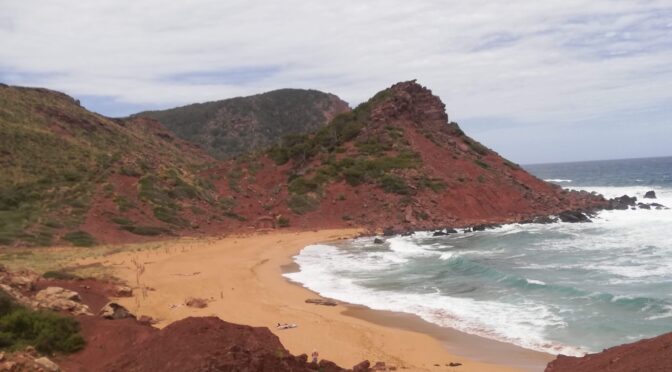Views: 1086
Menorca is not known for rivers. The lack of significant mountain ridges makes it difficult for permanent surface watercourses to exist. Even though locals proudly refer to Monte Toro as “the mountain,” the island’s geography has its limitations.
One notable exception was the river in Cala Galdana, which drew water from the confluence of springs in the Algendar Gorge. The towering vertical cliffs of this magical spot allowed rain falling on the adjacent plains to infiltrate and emerge at the ravine’s edge, sustaining the torrent year-round.
Today, extensive water extractions for residential, tourist, and agricultural use make it almost impossible for those springs to flow. As a result, the torrents flow for shorter periods and no longer meet the criteria to be called rivers.
Yet geologists tell us that part of the island owes its very existence to the action of massive freshwater rivers. Around 250 million years ago, vast rivers transported pebbles, sand grains, and clay from towering mountains, depositing them in layers that eventually became sedimentary rock. The high levels of iron oxide in these areas stained the materials a striking reddish hue.
When we visit the stunning landscape of Cala Pilar, the ochre sand is adorned with red hills formed from those ancient river deposits. These rocks often contain quartz particles, earning them the local name “pedra esmoladora” (whetstone).
Rivers and torrents have their own logic. They collect water from vast areas and channel it towards the sea. When heavy rains fall, they overflow, reclaiming land and streets before converging again on their path to the ocean.
Ancient wisdom sought to manage water’s force carefully. Channels were built with gentle slopes to slow the flow, allowing more water to infiltrate aquifers. Controlled flood zones were designed to contain and reduce the water’s energy. In some areas, thick transverse walls, known as fortins, were constructed for the same purpose.
The European Union is revisiting these principles today. Faced with scientific reports warning of more frequent extreme weather events due to climate change, practical and effective water management strategies are being prioritized.
Current guidelines, built on experiences from yesteryear, emphasize keeping rivers and streams free-flowing while also preserving and restoring vegetation along their banks. It is not a matter of choosing one or the other—it is about combining both approaches.
Locally, some advocate for fully clearing riverbeds or even cementing them, a policy that accelerates water flow and could have significant consequences downstream. This is a debate that will likely intensify as storm events become more frequent.
Now, as the island breathes, it’s a good time to walk the paths of Menorca’s red landscapes, reflect on its origins, and consider the challenges ahead.
(This text is an adaptation of the original article published by Miquel Camps, as coordinator of territorial policy for the GOB, in the Menorca newspaper on 26/11/2024).

